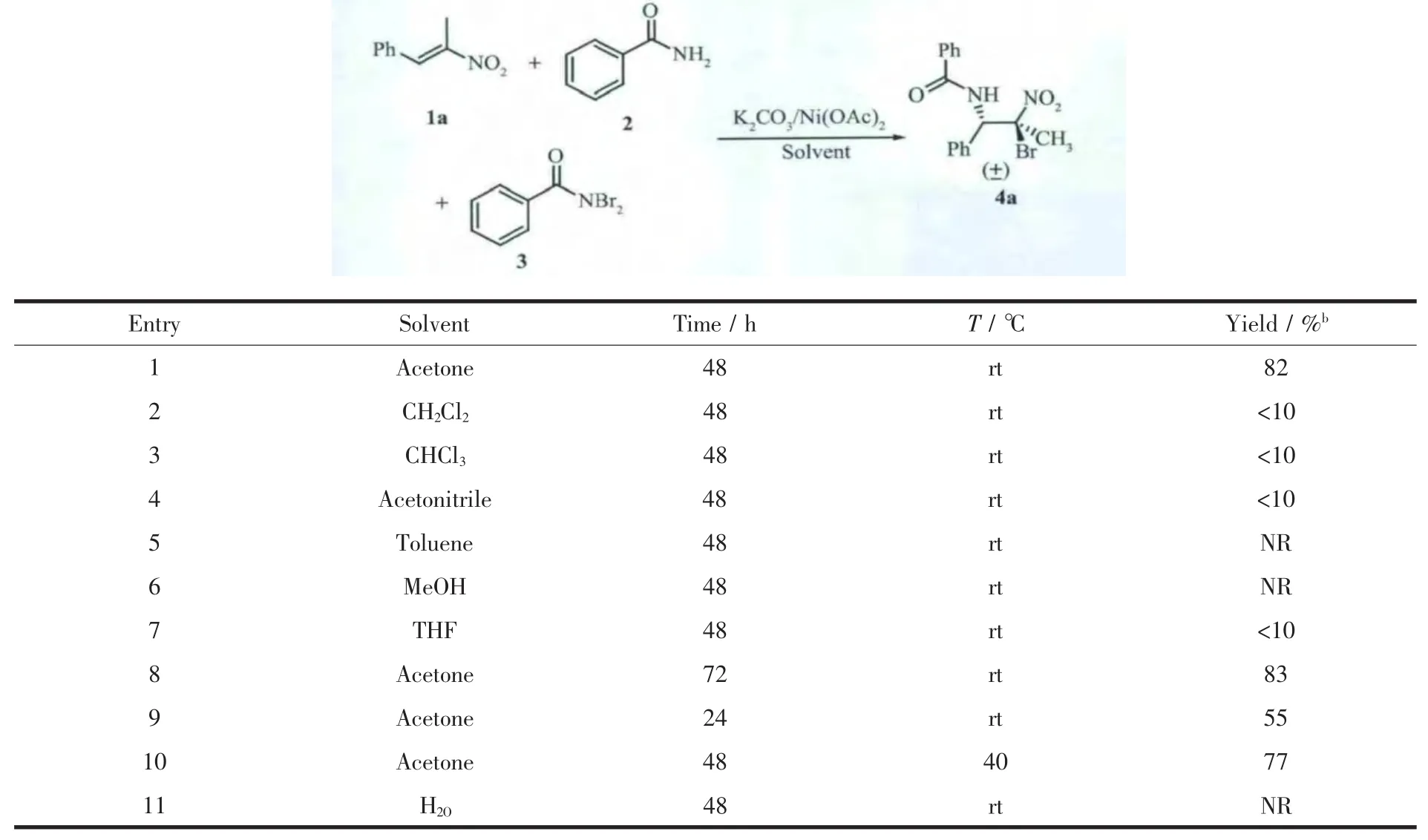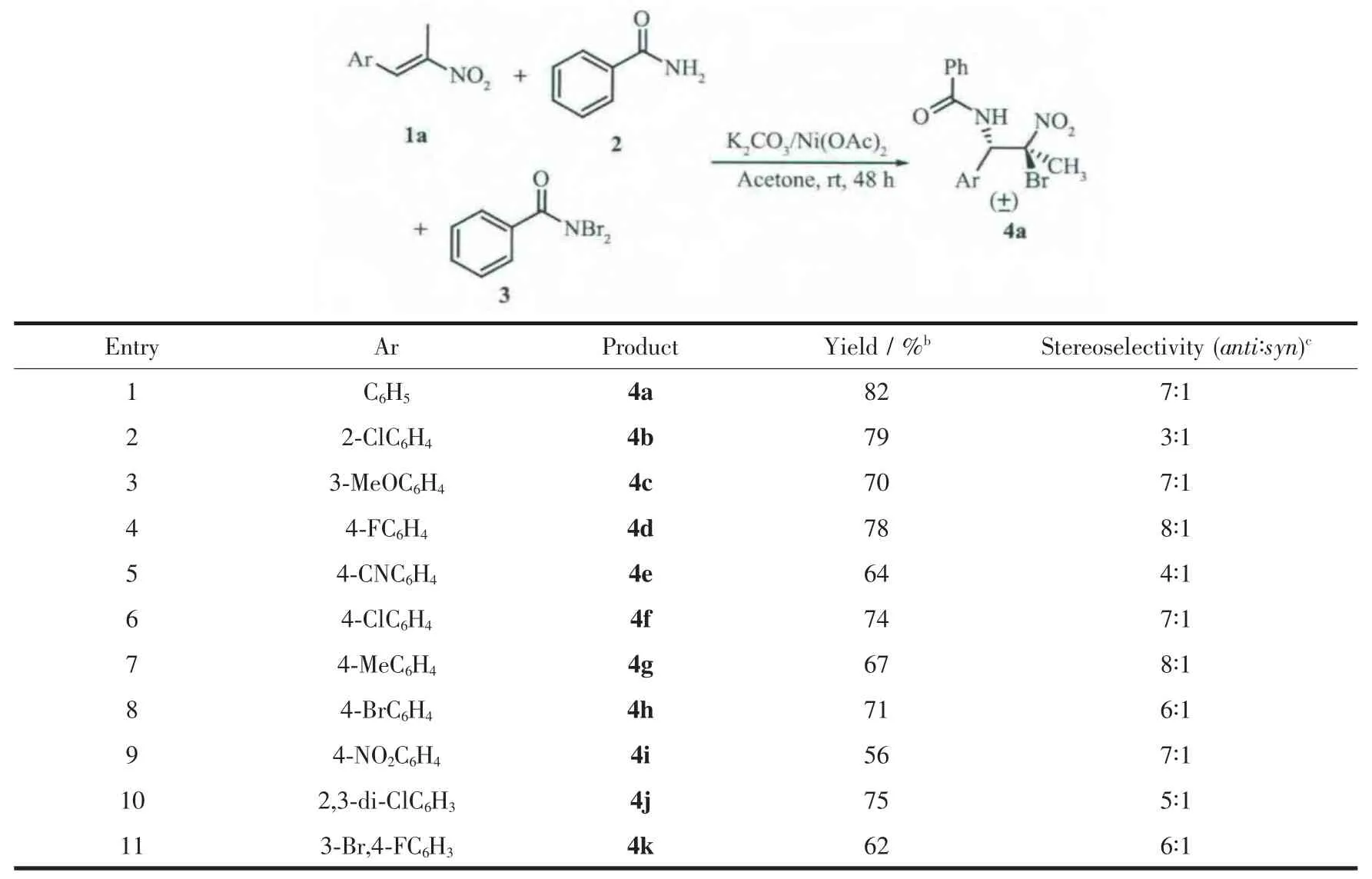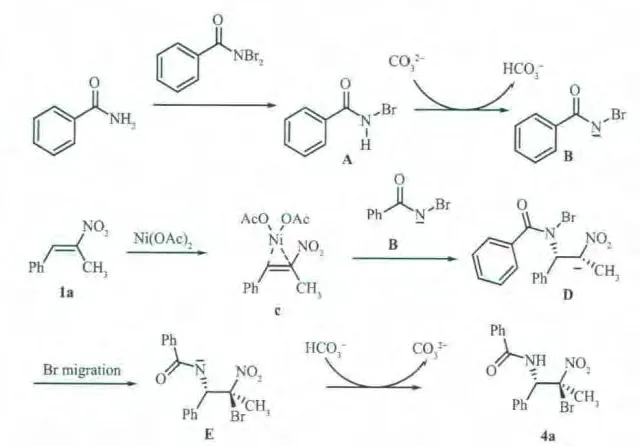K2CO3/Ni(OAc)2催化下的以苯甲酰胺和N,N-二溴苯甲酰胺為氮溴源的胺溴化反應(yīng)
陳 晟 韓建林*,,2 李桂根 潘 毅*,,2
(1南京大學(xué)化學(xué)化工學(xué)院,配位化學(xué)國家重點實驗室,南京 210093)
(2南京大學(xué)化學(xué)與生物醫(yī)學(xué)科學(xué)研究所,南京 210093)
(3化學(xué)與生物化學(xué)系,德克薩斯理工大學(xué),79409-1061,美國)
0 Introduction
Aminohalogenation of functionalized olefins plays an important role among all the methodologies for the preparation of vicinal haloamines[1],because it can construct carbon-nitrogen and carbon-halogen bonds in tandem fashions at the same time[2-11].The vicinal haloamines are also an important class of building blocks in organic and medicinal chemistry[12],as the halogen group can serve as a reactive functional group in substitution and coupling reactions,which have been demonstrated broad utility for the fine chemicals,synthetic intermediates and natural products[13-17].In the past decade,great development has been made on aminohalogenation reaction due to the exploration of several functionalized alkenes,such as α,β-unsaturated carboxylic esters[18-19],α,β-unsaturated nitriles[20],α,βunsaturated ketones[21-25]and so on[26-27].Especially,βnitrostyreneswereemployed asa new classof substrates for aminohalogenation,which have many advantages,including facile reaction conditions,diversification ofnitrogen source,oppositeregiochemistry and dramatically shorter reaction time[28-39].Also,the resulted vicinal nitro haloamine products can be easily converted into vicinal diamines[40-41].
Recently,severalnitrogen sources,such as imide[31],amide[30]and carbamate[32-36]have been used for β-nitrostyrene, and dihalogenated nitro amino compounds were formed.Our previous reports have shown that the nitrogen/halogen sources have a great effect on the formation of the final products in these systems,especially when β-methyl-β-nitrostyrenes are used as alkenes substrates[39,42].Furthermore,we can investigate the stereochemistry of aminohalogenation by using β-methyl-β-nitrostyrenes as substrates.So,it is essential to develope more efficient nitrogen source for aminohalogenation of β-methyl-β-nitrostyrenes.
Benzoyl is a useful group in synthetic and medicinal chemistry,especially with a halogen group on adjacent position,such as for the preparation of isoxazole,as well as for the synthesis of Pro-Drug[43-44].So,using benzamide as nitrogen source for aminohalogenation of β-methyl-β-nitrostyrenes becomes very interesting and challenging.Herein,we report a new aminobromination reaction of β-methyl-β-nitrostyrenes with benzamide/N,N-dibromobenzamide as nitrogen/brominesourcebyusingK2CO3/Ni(OAc)2asco-catalyst.
1 Experimental
1.1 General methods
Solvents were dried and distilled prior to use.Flash chromatography was performed on silica gel 60(GF-254)TCL plates(20 cm×20 cm).Melting points were uncorrected.IR spectra were collected with a Bruker Vector 22 instrument(KBr pellets).1H NMR(300 MHz)and13C NMR(75 MHz)(TMS was used as internal standard)were recorded on a 300 MHz spectrometer.HR-MS of the new compounds were measured with a Mariner TOF-ESI mass spectrometer
1.2 General procedure for aminobromination
To a dry round-bottomed vial was added βmethyl-β-nitrostyrenes 1(0.5 mmol),PhCONH22(121 mg,1 mmol),PhCONBr23 (278 mg,1 mmol),K2CO3(13.8 mg,0.1 mmol,20mol%)and Ni(OAc)2(1.8 mg,1mol%).Then 5 mL acetone was added into the vial.The mixture was electromagnetically stirred at room temperature for 48 h.The resulting solution was quenched with saturated Na2SO3(3.0 mL).The organic layer was separated and the aqueous layer was extracted with EtOAc (2 ×20 mL).The combined organic layers were dried with anhydrous Na2SO4,filtered and the solvent was removed to give the crude product,which was purified by preparative TLC plate.
N-2-bromo-2-nitro-1-phenylpropyl)benzamide 4a.White solid (157 mg,82%yield).m.p.91~92 ℃.1H NMR(300 MHz,CDCl3) δ 7.88~7.91(m,2H),7.59~7.52(m,4H),7.38~7.27(m,5H),5.95(d,J=9.6 Hz,1H),2.33(s,3H).13C NMR(75 MHz,CDCl3)δ 166.5,134.1,133.6,132.2,129.4,129.1,128.1,124.5,120.5,96.0,61.1,29.7 HR-MS [M+Na+]:Calcd.for C16H15Br N2O3Na:385.015 8,Found:385.015 0.IR(KBr):3 277,2 849,1 703,1 634,1 600,1 559,1 530,1 446,1 228,1 104 cm-1.
N-(2-bromo-1-(2-chlorophenyl)-2-nitropropyl)benzamide 4b.White solid (165 mg,79%yield).m.p.:136~138 ℃.1H NMR(300 MHz,CDCl3)δ 8.13~8.15(m,1H),7.90~7.93(m,2H),7.54~7.49(m,5H),7.31~7.25(m,2H),6.54(d,J=8.4 Hz,1H),2.32(s,3H).13C NMR (75 MHz,CDCl3) δ 166.3,134.9,133.4,132.7,130.5,129.0,128.8,128.0,127.2,124.4,120.5,94.2,57.1,28.1.HR-MS[M+Na+]:Calcd.for C16H14Br ClN2O3Na:418.976 9,Found:418.976 8.IR(KBr):3 273,2 924,1 701,1 638,1 557,1 530,1 477,1 229,1 100 cm-1.
N-(2-bromo-1-(3-methoxyphenyl)-2-nitropropyl)benzamide 4c.White solid (145 mg,70%yield).m.p.:60~62 ℃.1H NMR (300 MHz,CDCl3)δ 7.88~7.90(m,3H),7.51~7.58(m,4H),8.88~8.92(m,3H),5.91(d,J=9.0 Hz,1H),3.80(s,3H),2.32(s,3H).13C NMR(75 MHz,CDCl3) δ 166.5,159.8,135.5,133.6,132.2,130.2,128.8,127.8,127.2,120.4,114.2,95.8,61.1,55.3,29.7.HR-MS [M+Na+]:Calcd.for C17H17Br N2O4Na:415.0261,Found:415.0264.IR (KBr):3 261,2 924,1 703,1 645,1 602,1 558,1 446,1 386,1 075 cm-1.
N-(2-bromo-1-(4-fluorophenyl)-2-nitropropyl)benzamide 4d.White solid (157 mg,78%yield).m.p.:136~137 ℃.1H NMR(300 MHz,CDCl3)δ 7.95~7.81(m,3H),7.62~7.50(m,4H),7.32(m,1H),7.07~7.04(m,2H),5.94 (d,J=9.6 Hz,1H),2.32 (s,3H).13C NMR (75 MHz,CDCl3)δ 166.5,164.8,161.4,133.4,132.3,130.5,129.0,127.8,127.2,120.5,116.3(d,J=22.5 Hz),115.9,115.6,96.1,60.4,29.6.HR-MS[M+Na+]:Calcd.for C16H14BrFN2O3Na:403.006 4,Found:403.008 4.IR(KBr):3 246,2 959,1 701,1 664,1 603,1 556,1 386,1 340,1 301,1 076 cm-1.
N-(2-bromo-1-(4-cyanophenyl)-2-nitropropyl)benzamide 4e.White solid (132 mg,64%yield).m.p.:139~141 ℃.1H NMR(300 MHz,CDCl3)δ 7.80~7.89(m,3H),7.63~7.70(m,3H),7.53~7.49(m,4H),5.99(d,J=9.0 Hz,1H),2.34 (s,3H).13C NMR (75 MHz,CDCl3) δ 166.6,138.4,133.4,129.5,129.1,127.2,120.5,117.9,113.5,102.1,95.7,60.8,29.7.HR-MS[M+Na+]:Calcd.for C17H14BrN3O3Na:410.011 1,Found:410.010 5.IR(KBr):3 098,2 922,2 231,1 670,1 636,1 564,1 522,1 332,1 276,1 230,1 143 cm-1.
N-(2-bromo-1-(4-chlorophenyl)-2-nitropropyl)benzamide 4f.White solid (155 mg,74%yield).m.p.:147~149 ℃.1H NMR(300 MHz,CDCl3)δ 7.89~7.87(m,3H),7.60~7.52(m,4H),7.34~7.28(m,3H),5.92(d,J=9.6 Hz,1H),2.32(s,3H).13C NMR(75 MHz,CDCl3)δ 166.5,135.5,133.3,132.7,129.9,129.5,127.9,127.2,120.4,95.9,60.5,29.5.HR-MS[M+Na+]:Calcd.for C16H14BrClN2O3Na:418.976 9,Found:418.973 3.IR (KBr):3 246,2 945,1 700,1 663,1 558,1 446,1 385,1 343,1 077 cm-1.
N-(2-bromo-2-nitro-1-p-tolylpropyl)benzamide 4g.White solid (134 mg,67%yield).m.p.:125~128 ℃.1H NMR (300 MHz,CDCl3) δ 7.91~7.87 (m,3H),7.58~7.49(m,4H),7.19~7.16(m,3H),5.90(d,J=9.6 Hz,1H),2.34(s,3H),2.31(s,3H).13C NMR(75 MHz,CDCl3) δ 166.4,139.4,133.8,132.1,131.1,129.4,127.9,127.2,120.4,96.2,57.8,28.8,21.2 ppm.HRMS [M+Na+]:Calcd.for C17H17BrN2O3Na:399.031 5,Found:399.0314.IR(KBr):3 244,2 943,1 664,1 558,1 509,1 482,1 273,1 077 cm-1.
N-(2-bromo-1-(4-bromophenyl)-2-nitropropyl)benzamide 4h.White solid (164 mg,71%yield).m.p.:150~152 ℃.1H NMR(300 MHz,CDCl3)δ 7.89~7.87(m,2H),7.80~7.48(m,6H),7.29~7.19(m,2H),5.91(d,J=9.0 Hz,1H),2.31 (s,3H).13C NMR (75 MHz,CDCl3) δ 166.5,133.4,132.3,128.9,127.8,127.2,124.4,123.7,120.5,95.8,60.6,29.5.HR-MS [M+Na+]:Calcd.for C16H14Br2N2O3Na:462.926 3,Found:462.928 6.IR (KBr):2945,1664,1600,1509,1482,1307,1076,1009 cm-1.
N-(2-bromo-2-nitro-1-(4-nitrophenyl)propyl)benzamide 4i.White solid(120 mg,56%yield).m.p.:123~124 ℃.1H NMR (300 MHz,CDCl3)δ 8.26~8.22(m,2H),7.98~7.87(m,3H),7.82~7.51(m,5H),6.02(d,J=9.0 Hz,1H),2.36(s,3H)ppm.13C NMR(75 MHz,CDCl3) δ 166.6,148.4,141.2,132.8,129.8,129.4,127.8,127.2,123.8,120.4,95.7,60.6,29.8.HR-MS[M+Na+]:Calcd.for C16H14BrN3O5Na:430.000 9,Found:430.000 6.IR(KBr):3 172,2 924,1 660,1 625,1 578,1 143,1 026 cm-1.
N-(2-bromo-1-(2,3-dichlorophenyl)-2-nitropropyl)benzamide 4j.White solid(170 mg,75%yiled).m.p.:154~156 ℃.1H NMR(300 MHz,CDCl3)δ 7.92~7.89(m,2H),7.60~7.47(m,5H),7.18~7.12(m,2H),6.58(d,J=8.4 Hz,1H),2.33(s,3H).13C NMR(75 MHz,CDCl3)δ 166.3,135.2,133.4,131.4,129.0,128.9,128.2,127.5,125.7,124.5,120.5,93.8,57.9,29.2.HR-MS[M+Na+]:Calcd.for C16H13BrCl2N2O3Na:452.937 9,Found:452.9394.IR(KBr):3261,2924,1700,1 640,1 559,1 528,1 181,1 102 cm-1.
N-(2-bromo-1-(3-bromo-4-fluorophenyl)-2-nitropropyl)benzamide 4k.White solid(149 mg,62%yield).m.p.:96~99 ℃.1H NMR (300 MHz,CDCl3)δ 7.90~7.87(m,3H),7.60~7.52(m,5H),7.28~7.09(m,1H),5.88(d,J=9.3 Hz,1H),2.32(s,3H).13C NMR(75 MHz,CDCl3) δ 166.6,161.2,157.8,133.7,133.5,133.1,132.7,131.8,129.5,129.0,127.3,117.2(d,J=22.5 Hz),110.0,95.6,60.0,30.4.HR-MS [M+Na+]:Calcd.for C16H13Br2FN2O3Na:482.915 0,Found:482.915 3.IR(KBr):2934,1665,1509,1481,1445,1248,1129,cm-1.
2 Results and discussion
Initially,we chose NBS as model bromine source for the aminobromination of β-methyl-β-nitrostyrene and benzamide catalyzed by K2CO3with CH2Cl2as solvent.However,no desired product was obtained,even the reaction time was extended to 72 h.Then the combination of benzamide/N,N-dibromobenzamide was tried for this aminobromination(Table 1).No reaction was observed without any catalyst(entry 1).Then,a variety of inorganic bases,such as K2CO3,Na2CO3,KOH and K3PO4were utilized as the catalyst for this reaction.However,no reaction was found for all these catalysts (entries 2~5).Metal catalyst also could not catalyze the reaction to form the desired bromoamine products(entries 6~8).After many trials,we found the reaction could give the desired product with 30%yield if the reaction is catalyzed by the combination of K2CO3/MnSO4(entry 9).To improve the yield,other metal salts with K2CO3were examined(entries 10 and 11).Higher yield was obtained in the binary catalyst system consisted of K2CO3and Ni(OAc)2(82%,entry 11).Three other bases were also investigated in the presence of Ni(OAc)2,but no improvement was found(entries 12 ~14).Finally,the similar chemical yield was found when the loading amount of Ni(OAc)2was increased to 5mol% (entry 15).Organic base,like triethylamine was tried as catalyst with Ni(OAc)2,however,no desired product was observed(entry 16).
Then,the reaction conditions were further optimized.As shown in Table 2,no desired products were observed when methanol or toluene was used as solvent (entries 5 and 6).The best solvent for the reaction was acetone,giving the corresponding product with the highest yield (82%,entry 1).The reaction with CH2Cl2,CHCl3,acetonitrile or THF as solvent almost could not proceed,and only trace amount of haloamine products were detected(entries2~4 and 7).Water was also tried as solvent for the reaction,but no reaction was observed.The reaction time also showed effects on the chemical yields.A dramatic lower chemical yield was obtained when the reaction was stopped at 24 h (55%yield,entry 9),although no better yield was obtained when the reaction time was extended to 72 h (entry 8).Increasing the temperature to 40℃also gave no improvement on the yield(entry 10).

Table 1 Optimization of catalystsa

Table 2 Optimization of reaction conditionsa
Then,several α, β-unsaturated nitro compounds were subjected to this reaction to examine the scope and limitation ofthe currentaminobromination reaction(Table 3).As shown in Table 3,a wide scope of α, β-unsaturated nitro compounds worked well in the reaction,and proceeded completely within 48 h giving 56%~82%chemical yield.The electronegativity of the substituents on the aromatic rings showed almost no effects on the chemical yield.Both electronrich(entries 3 and 7)and electron-deficient substrates(entries 2,4~6 and 8~9)could participate well in the reaction,even for methoxy (entry 3)and fluoro(entry 4)groups.Notably,substrates with two substituent groups on aromatic ring were also well tolerated in this reaction (entries 10 and 11).These substrates showed moderate to good stereoselectivities,with ratios ranging from 3∶1 to 8∶1.Furthermore,only one regioisomer was observed for each of these cases.
According to the regio-and stereochemistry of the reaction and previous reports,a Michael addition pathway is proposed in Scheme 1 for this K2CO3/Ni(OAc)2catalyzed aminobromination reaction.In the initial step, N,N-dibromobenzamide reacts with benzamide forming the intermediate A, which undergoes deprotonation by K3CO3and results in intermediate B.Here,the nucleophile B cannot add directly to nitrostyrene comparing to our previous reports[34-35].This Michael addition needs the promotion of the catalyst Ni(OAc)2,and gives the intermediate D.Then,the Br+ion migrates from N-Br of amide to the negative center to form intermediate E.The intermediate E obtains a proton from HCO3-,giving the final product 4a and the catalyst CO32-.In the proposed mechanism,one catalyst K2CO3is used for deprotonation of nitrogen source,and the other catalyst Ni(OAc)2is used for the activation of nitrostyrene,which is different from the previous aminohalogenation reactions of nitrostyrenes[34-35].

Table 3 Aminobromination of various β-methyl-β-nitrostyrenes derivativesa

Scheme 1 Michael addition pathway for the K2CO3/Ni(OAc)2catalyzed aminobromination reaction
3 Conclusions
In summary,we have developed a new aminobromination reaction of β-methyl-β-nitrostyreneswith benzamide/N,N-dibromobenzamide as nitrogen/bromine source,which needs K2CO3/Ni(OAc)2as the co-catalyst.This facile and efficient system tolerates a broad range of substrates,giving moderate to good yield and high regio-and stereoselectivity.Further study on aminobromination of this nitrogen source is focused on the asymmetric catalyst.
Acknowledgements:We gratefully acknowledge the financial support from the National Natural Science Foundation of China(No.21102071)and the Fundamental Research Funds for the Central Universities(No.1107020522 and No.1082020502).The Jiangsu 333 program (for Pan)and Changzhou Jin-Feng-Huang program(for Han)are also acknowledged.
[1]Kemp J E.Comprehensive Organic Synthesis:Vol.3;Trost B M,Fleming I,Eds.;Oxford:Pergamon Press,1991:469-513
[2]Yeung Y Y,Gao X,Corey E J.J.Am.Chem.Soc.,2006,128:9644-9645
[3]Griffith D A,Danishefsky S J.J.Am.Chem.Soc.,1991,113:5863-5864
[4]Lessard J,Driguez H,Vermes J P.Tetrahedron Lett.,1970,11:4887-4891
[5]Daniher F A,Butler P E.J.Org.Chem.,1968,33:4336-4340
[6]Orlek B S,Stemp G.Tetrahedron Lett.,1991,32:4045-4048
[7]Manzoni M R,Zabawa T P,Kasi D,et al.Organometallics,2004,23:5618-5621
[8]Danielec H,Klugge J,Schlummer B,et al.Synthesis,2006:551-556
[9]Xu L,Du H F,Shi Y.J.Org.Chem.,2007,72:7038-7041
[10]Du H F,Zhao B G,Shi Y.J.Am.Chem.Soc.,2007,129:762-763
[11]Li G,Saibabu Kotti S R S,Timmons C.Eur.J.Org.Chem.,2007:2745-2758
[12]Qui J,Silverman R B.J.Med.Chem.,2000,43:706-720
[13]Chen D,Timmons C,Guo L,et al.Synthesis,2004:2749-2784
[14]Chen D,Kim S H,Hodges B,et al.ARKIVOC,2003(xii):56-62
[15]Chen D,Guo L,Liu J,et al.Org.Lett.,2005,7:921-924
[16]Mei H B,Yan L J,Han J L,et al.Chem.Biol.Drug Des.,2010,76:392-396
[17]Zhang G Q,An G H,Zheng J,et al.Tetrahedron Lett.,2010,51:987-989
[18]Li G,Wei H X,Kim S H,et al.Org.Lett.,1999,1:395-397
[19]Wei H X,Kim S H,Li G.Tetrahedron,2001,57:3869-3871
[20]Han J L,Zhi S J,Wang L Y,et al.Eur.J.Org.Chem.,2007:1332-1337
[21]Sun H,Zhang G Q,Zhi S J,et al.Org.Biol.Chem.,2010,8:4236-4239
[22]Chen Z G,Wei J F,Li R T,et al.J.Org.Chem.,2009,74:1371-1373
[23]Thakur V V,Talluri S K,Sudalai A.Org.Lett.,2003,5:861-864
[24]Wu X L,Xia J J,Wang G W.Org.Biomol.Chem.,2008,6:548-553
[25]Wei J F,Zhang L H,Chen Z G,et al.Org.Biomol.Chem.,2009,7:3280-3284
[26]Li W L,Chen Z G,Zhou J M,et al.Chin.J.Chem.,2012,30:830-836
[27]Qi M H,Shao L X,Shi M.Chin.J.Chem.,2011,29:2739-2743
[28]Zhi S J,Han J L,Lin C,et al.Synthesis,2008:1570-1574
[29]Zhi S J,Sun H,Lin C,et al.Sci.China Chem.,2010,53:140-146
[30]Zhi S J,Mei H B,Zhang G Q,et al.Sci.China Chem.,2010,53:1946-1952
[31]Qian Y,Ji X Y,Zhou W,et al.Tetrahedron,2012,68:6198-6203
[32]Mei H B,Han J L,Li G,et al.RSC Adv.,2011,1:429-433
[33]Mei H B,Xiong Y W,Qian Y,et al.RSC Adv.,2012,2:151-155
[34]Ji X Y,Mei H B,Qian Y,et al.Synthesis,2011:3680-3686
[35]Ji X Y,Duan Z Q,Qian Y,et al.RSC Adv.,2012,2:5565-5570
[36]Chen Z G,Zhao P F,Wang Y.Eur.J.Org.Chem.,2011:5887-5893
[37]Chen Z G,Wang Y,Wei J F,et al.J.Org.Chem.,2010,75:2085-2088
[38]Zhi S J,Sun H,Zhang G Q,et al.Org.Biomol.Chem.,2010,8:628-631
[39]Zhi S J,An G H,Sun H,et al.Tetrahedron Lett.,2010,51:2745-2747
[40]Enders D,Wiedemann J.Synthesis,1996:1443-1450
[41]Lucet D,Toupet L,Gall T L,et al.J.Org.Chem.,1997,62:2682-2683
[42]Chen S,Han J L,Li G G,et al.Tetrahedron Lett.,2013,54:2781-2784
[43]ChudasamaV,WildenJD.Chem.Commun.,2008:3768-3770
[44]Ferjancic Z,Matovic R,Saicic R N.Tetrahedron,2006,62:8503-8514

